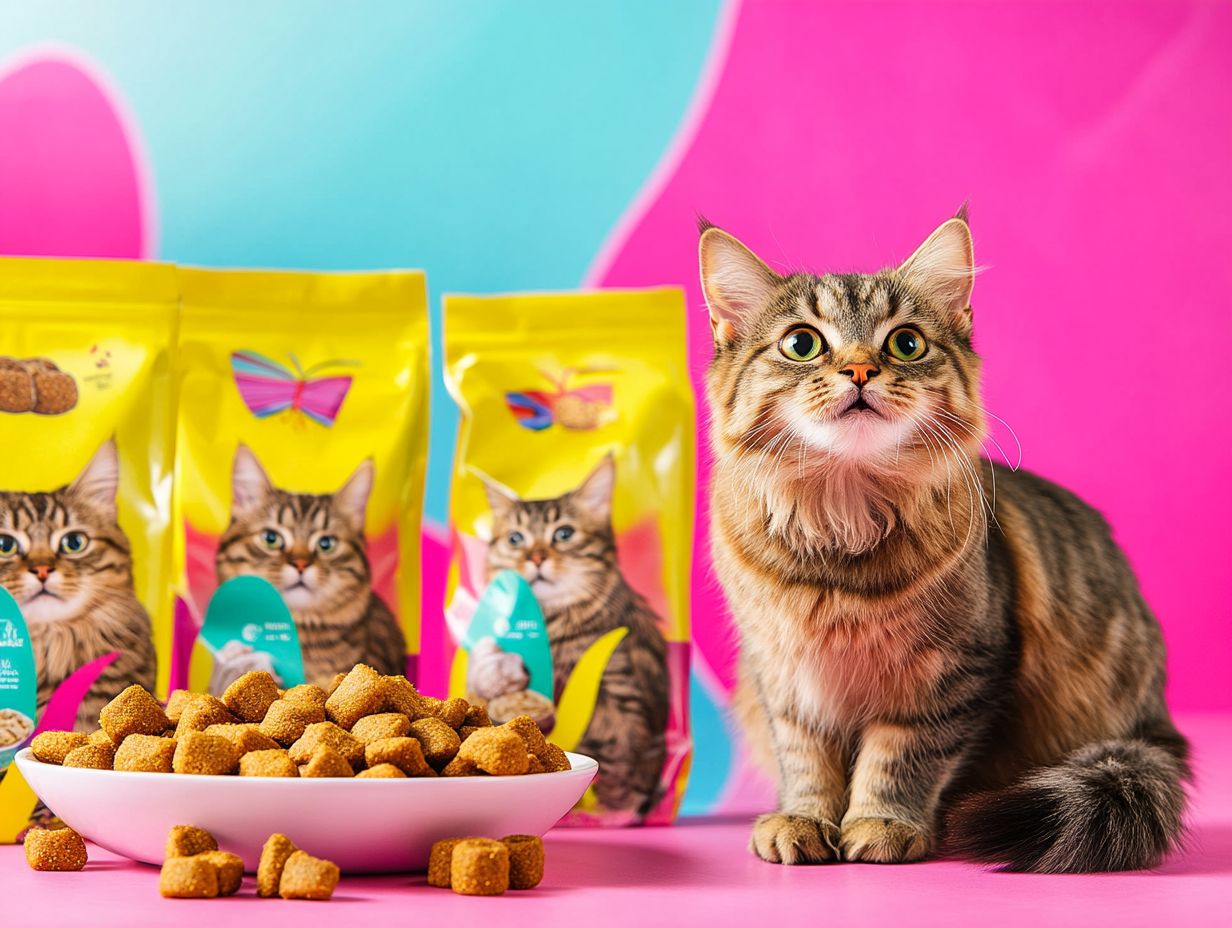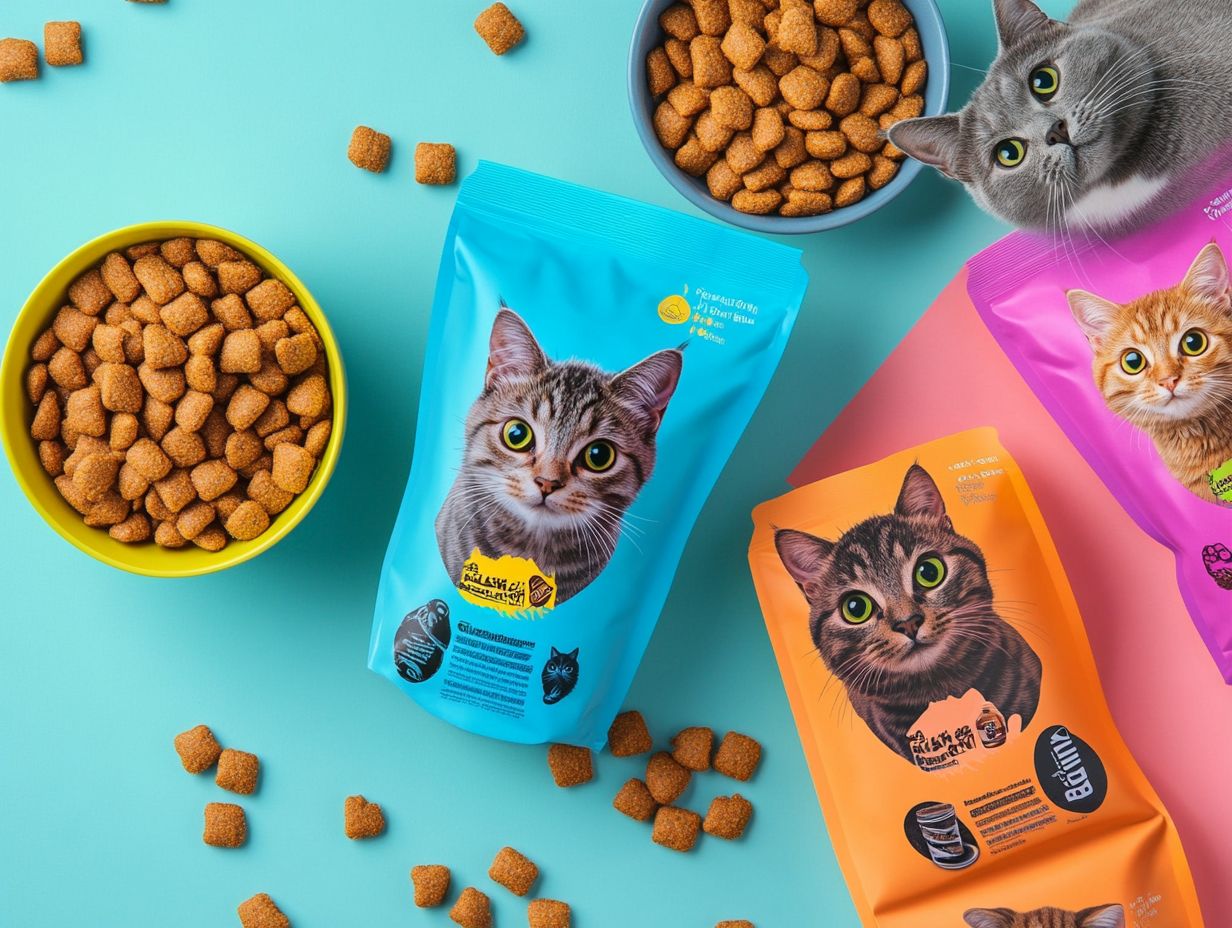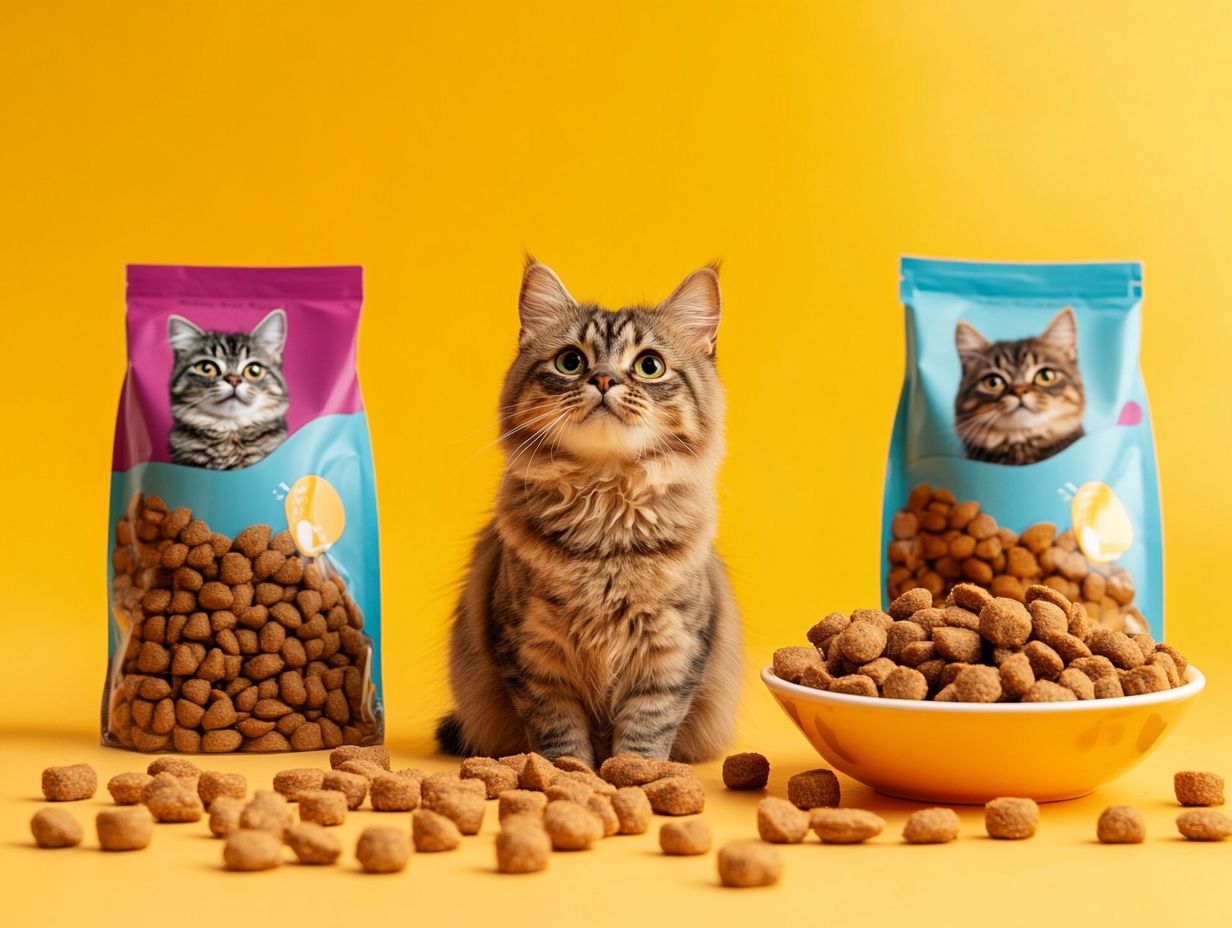Cats can experience allergies, often related to proteins, which require careful dietary management that aligns with their obligate carnivore nature. Cat allergies often involve protein sensitivity and require careful monitoring of their diet.
From common allergens to telltale symptoms, understanding feline allergies is crucial for every cat owner. Cat owners need to be aware of allergy triggers to ensure their pets’ comfort. It is essential to consult a veterinarian before making any dietary changes, particularly regarding hypoallergenic diets and the introduction of new proteins.
This article explores what allergies are in cats, how they’re diagnosed, and the role of hypoallergenic cat food, including wet food and canned cat food options, in managing these sensitivities. Monitoring for nutritional deficiencies in cats on hypoallergenic diets is important, and some may require supplements to meet their dietary requirements.
It also recommends some vet-recommended dry cat foods, such as those with a single carbohydrate source, that support digestive health and outlines ingredients to avoid. While certain brands are mentioned, the effectiveness of hypoallergenic diets can vary, and it’s essential to consult with a veterinarian for personalized recommendations.
Discover how to keep your furry friend comfortable and healthy!
Key Takeaways:

- Hypoallergenic cat food can help alleviate symptoms of allergies in cats by using alternative protein sources and avoiding common allergens.
- The vet-recommended dry cat foods for allergies include brands like Hill’s Science Diet, Blue Buffalo, Purina Pro Plan, Royal Canin, and Natural Balance.
- When choosing a hypoallergenic cat food, avoid ingredients like corn, wheat, soy, artificial preservatives, colors and flavors, and meat by-products. Opt for cat food formulas that emphasize ingredient quality and safe preservatives.
What Are Allergies in Cats?
Allergies in cats are a common concern for cat owners. They occur as an immune system response, where the body reacts to certain substances, known as allergens, that are typically harmless.
Cats can develop allergies due to specific food ingredients, environmental factors, or insect bites. These allergic reactions can lead to various health issues, including skin irritations, gastrointestinal disturbances, and respiratory problems. Chronic conditions may also exacerbate their allergy response.
It is essential for cat owners to understand the different types of allergies, their causes, and symptoms. Identifying allergy triggers is a crucial aspect of effective management and treatment, particularly regarding dietary changes and hypoallergenic options that can enhance a cat’s overall health.
What Are the Common Allergens for Cats?
Common allergens for cats often include proteins from various sources and environmental factors, making it crucial for cat owners to identify the specific allergens responsible for their pets’ allergic reactions. These allergens can range from ingredients in popular cat food brands, such as chicken, beef, and fish, to environmental triggers like pollen and dust mites.
The significance of a broad ingredient list is important in this context. Hydrolyzed proteins, which are protein molecules broken down into smaller components, can help reduce the likelihood of allergic reactions and are a safe option for sensitive cats. This approach aligns with processing standards that ensure ingredient control.
Unique protein sources, such as venison or duck, offer alternatives that may not have been previously consumed, potentially lowering the risk of allergies. Dietary trials can assist in identifying possible food sensitivities by gradually introducing new foods and monitoring for reactions, enabling owners to better understand what their cats can safely eat.
What Are the Symptoms of Allergies in Cats?
Cats can exhibit a variety of symptoms when they suffer from allergies, with the most common reactions affecting either skin health or digestive health. These symptoms indicate that the cat’s body is responding adversely to certain allergens. Frequent signs include itching, redness, vomiting, and diarrhea.
Allergies can also lead to respiratory issues, which can be distressing for both cats and their owners, as these problems may significantly impact the pet’s quality of life.
Symptoms in cats can arise from various factors, including food intolerances and environmental allergens such as pollen or dust mites. It is essential for owners to recognize these symptoms, as doing so can aid in identifying the specific type of allergy and its potential triggers, allowing for appropriate treatment from a veterinarian.
Food Storage and Safety
Proper handling and storage of cat food, particularly hypoallergenic diets, are crucial for maintaining safety and preventing spoilage. Store food in a cool, dry place, and ensure that the packaging is sealed tightly after use. Always check the expiration date and avoid leaving food out for extended periods to reduce the risk of contamination.
Risks and Benefits of Homemade or Raw Diets
Homemade or raw diets can pose health risks and should only be considered under veterinary guidance. While they may provide alternatives, it’s essential to ensure that these diets meet all of a cat’s nutritional needs and do not increase allergy risks.
Environmental Management
To reduce allergens in the home, cat owners can implement various strategies. Regularly cleaning living spaces, using air purifiers, and maintaining a dust-free environment can significantly minimize exposure to environmental allergens, complementing dietary management.
When a cat’s immune response is overly strong, symptoms may worsen. Providing immune support through high-quality diets—defined as those that meet the AAFCO (Association of American Feed Control Officials) standards—and hypoallergenic foods can help alleviate some symptoms and enhance overall health. Owners are encouraged to consult with a veterinarian about specialized diets and/or supplements that can bolster the immune system, ensuring their cat remains comfortable and happy. Additionally, it’s important to note that cats are obligate carnivores, meaning their diets should primarily consist of animal-source proteins.
How Are Allergies Diagnosed in Cats?
Diagnosing allergies in cats typically involves a veterinarian and employs various methods, including skin tests, blood tests, and dietary trials, to identify specific allergens contributing to the cat’s allergies. This comprehensive process ensures that the diagnosis is accurate and tailored to the unique needs of each cat.
Veterinarians often use these diagnostic tools in conjunction with a thorough review of the cat’s medical history and environmental factors, which helps to identify potential triggers more easily. Veterinary prescription diets are sometimes recommended for managing severe allergies.
The significance of veterinary prescriptions is substantial, as they enable the use of targeted treatments—ranging from antihistamines to corticosteroids—that can provide considerable relief. Hypoallergenic diets play a crucial role in managing food-related allergies, with several studies demonstrating their effectiveness in improving long-term health.
One method employed is the elimination diet, which allows veterinarians to systematically expose the cat to different protein sources, leading to more precise identification of allergens. For more information, check out the Top-Rated Dry Cat Foods for Allergies: Crunchy and Hypoallergenic.
These methods not only enhance the quality of life for cats with allergies but also equip pet owners with actionable knowledge.
What Is Hypoallergenic Cat Food?
Hypoallergenic cat food is specifically formulated to meet the nutritional needs of cats with food sensitivities and allergies. It utilizes novel proteins and limited ingredient formulations to minimize allergic reactions. Consulting with a veterinarian before transitioning to any new diet is crucial, particularly for cats with medical conditions.
These diets are designed to exclude common food allergens found in traditional cat food, helping cat owners effectively manage their pets’ health issues.
How Does Hypoallergenic Cat Food Help with Allergies?

Hypoallergenic cat food is designed to manage allergic reactions by minimizing symptoms through a specialized diet that features carefully selected ingredients for cats with protein sensitivities and digestive issues. Feeding recommendations may vary based on individual dietary needs, and the effectiveness of hydrolyzed protein diets can also vary among individual cats; therefore, monitoring for any adverse reactions is essential.
Many brands, such as Hill’s Prescription Diet and Royal Canin, have meticulously crafted their recipes to provide immune support while alleviating allergy symptoms. However, it’s important to be aware of the potential risks associated with DIY hypoallergenic diets, as they may lead to nutritional deficiencies; therefore, owners should work with veterinarians to ensure balanced nutrition.
Hill’s formula includes omega-3 fatty acids, which help reduce inflammation and improve skin health, while Royal Canin incorporates a special blend of vitamins and antioxidants that bolster a cat’s immune system, ensuring that their food is not only gentle on their stomach but also beneficial for their overall well-being.
What Are the Best Dry Cat Foods for Allergies?
The best dry cat food for allergies is designed with specific nutrients to address the most common allergies and sensitivities in cats. It includes both hypoallergenic options and those with high palatability, ensuring that cats receive the essential nutrients they need to maintain their health.
Additionally, these formulations provide the necessary calories and nutrition, making it easier for cat owners to ensure dietary compliance. Cats with allergies should also adhere to specific caloric guidelines to prevent obesity.
1. Hill’s Science Diet Sensitive Stomach & Skin Dry Cat Food
Hill’s Science Diet Sensitive Stomach & Skin Dry Cat Food is a premium cat food formulated with high-quality ingredients and a balanced nutritional profile designed to support digestive and skin health in cats with allergic sensitivities. This product is an excellent choice for cat owners seeking to provide their pets with essential nutrition while minimizing the risk of allergic reactions.
The primary ingredients include easily digestible proteins and omega fatty acids, which are vital for maintaining skin and coat health (source: [insert scientific reference here]). These components help soothe skin irritations and bolster the immune system of cats with allergies. Additionally, prebiotic fibers are included to promote healthy gut flora, significantly enhancing digestive health.
What sets this cat food apart from others is its specific formulation for sensitive cats, which adheres to AAFCO and WSAVA guidelines for dietary sensitivity, ensuring that each meal is both delicious and beneficial and minimizing the risks of inappropriate diets.
2. Blue Buffalo Wilderness Indoor Chicken Recipe Grain-Free Dry Cat Food
Blue Buffalo Wilderness Indoor Chicken Recipe Grain-Free Dry Cat Food is a protein-rich formula specifically designed for indoor cats. It features real chicken as the primary source of protein and contains no grains that could trigger allergic reactions. This recipe meets the nutritional needs of cats with food sensitivities without compromising on taste. Made from high-quality, natural ingredients, it supports healthy weight management and overall well-being.
The Blue Buffalo Wilderness Indoor Chicken Recipe employs a limited ingredient approach that minimizes allergic responses, making it suitable for cats prone to sensitivities. Additionally, it includes specific fruits and vegetables such as blueberries and carrots that provide essential vitamins and minerals necessary for proper bodily function.
Many pet owners appreciate the absence of fillers and artificial additives, which enhance both digestibility and nutrient absorption for indoor cats. This formula also ensures a proper balance of nutrients and calories, helping to maintain a healthy weight while providing long-lasting energy. According to current feline obesity guidelines, it is important to monitor calorie intake and portion control to ensure optimal health for your cat.
Additionally, proper food storage and handling practices are essential to maintain the freshness and safety of the cat food.
3. Purina Pro Plan Sensitive Skin & Stomach Grain-Free Dry Cat Food
Purina Pro Plan Sensitive Skin & Stomach Grain-Free Dry Cat Food is specifically designed to support cats with sensitive skin and digestive issues. It features easily digestible ingredients and a grain-free formula to minimize allergy triggers, making it a reliable choice for cat owners seeking to address their pets’ dietary sensitivities.
This formula incorporates high-quality animal-source proteins, such as salmon and turkey, ensuring that allergic cats receive the necessary cat nutrition without triggering an allergic response. It is important to be aware of potential nutritional deficiencies in grain-free diets, particularly for obligate carnivores like cats. Additionally, the inclusion of specific antioxidants promotes immune support, contributing to the overall health of the cat.
With optimal fat levels, this food guarantees that even cats with sensitive stomachs feel full and satisfied without experiencing discomfort. Pet owners can feel confident that their beloved felines are receiving a nutritious diet tailored to their specific needs, making mealtime more enjoyable for both cats and their humans.
Before transitioning to any new diet, especially for cats with existing health conditions, it is crucial to consult with a veterinarian.
4. Royal Canin Veterinary Diet Selected Protein Adult PR Dry Cat Food
Royal Canin Veterinary Diet Selected Protein Adult PR Dry Cat Food is a veterinary-prescribed formula specifically designed for cats with food allergies. It utilizes a single carbohydrate source and selected protein to effectively minimize allergic reactions. This specialized diet not only provides essential nutrients but also addresses the unique dietary needs of cats with allergies.
Veterinary prescriptions ensure that the food aligns with the health requirements of each cat. The selected protein helps manage allergies by reducing the likelihood of an allergy response while still delivering adequate nutrition. Cat owners can obtain such diets through a veterinarian, emphasizing the importance of veterinary guidance.
Stringent processing standards and controls over ingredients ensure the integrity of the nutrients, resulting in a balanced diet that meets their nutritional requirements. This careful attention to formulation details helps alleviate allergy symptoms and enhance overall health, highlighting the effectiveness of specialized diets for managing chronic conditions and improving the quality of life for cats with dietary restrictions.
5. Natural Balance L.I.D. Limited Ingredient Diets Green Pea & Salmon Formula Grain-Free Dry Cat Food

Natural Balance L.I.D. Limited Ingredient Diets Green Pea & Salmon Formula Grain-Free Dry Cat Food is an excellent option for cats with food sensitivities, as it features a limited ingredient list with green peas and salmon as its primary protein source and single carbohydrate source. The inclusion of such high-quality ingredients ensures that cats receive the necessary nutrients without the risk of common allergens.
It is advisable to consult with a veterinarian regarding the necessity and safety of dietary supplements for cats, including proper dosages.
Additionally, special dietary needs for different life stages, such as kittens and senior cats, must be considered to highlight their unique nutritional requirements.
Lastly, it is essential to balance ethical and sustainability concerns with the primary focus on the cat’s health and nutritional needs.
This formulation is specifically designed to minimize allergic reactions while providing a balanced diet suitable for sensitive digestive systems. It is crafted to be designed to appeal to even the pickiest eaters, ensuring that they will enjoy it due to its delicious flavor, while introducing unique proteins, such as novel protein sources like duck or venison, that are less likely to trigger adverse reactions. Additionally, this formula includes omega fatty acids, which have been shown to promote skin and coat health.[1]
By simplifying the recipe, it addresses the dietary concerns of cats prone to allergies and supports their sensitive digestive systems, allowing them to enjoy the taste without the discomfort associated with common fillers or allergens. However, it’s essential to note that the ingredients that may trigger allergies can vary based on individual sensitivities, reinforcing the need for personalized dietary assessments.
What Ingredients Should Be Avoided in Cat Food for Allergies?
Managing allergies in cats requires that owners identify and avoid specific ingredients in cat food to prevent potential allergy triggers and food intolerances. It is crucial to consult with a veterinarian before making any dietary changes, especially for cats with known allergies.
Common ingredients that can trigger allergies include grains, artificial preservatives (such as BHA and BHT), and certain protein sources. For more information on suitable options, check out Top-Rated Dry Cat Foods for Allergies: Crunchy and Hypoallergenic.
1. Corn, Wheat, and Soy
Corn, wheat, and soy are common allergens found in cat food formulas, making them the primary ingredients to avoid for cats with food sensitivities or allergies. These grains can trigger allergic reactions and digestive issues, leading to discomfort in affected cats.
The main concern with these grains is their tendency to cause food intolerances, which can result in gastrointestinal upset and general malaise. Additionally, many commercial cat foods contain low-quality grains that fail to provide proper nutrition and can disrupt gut health. As obligate carnivores, cats have digestive systems adapted to process animal proteins rather than grains.
Many pet owners may not realize that a cat’s digestive system is not designed to handle these grains efficiently, potentially harming their pet’s well-being. For those looking to manage their cat’s diet, high-quality grain-free options may help, but it’s important to remember that grain-free does not necessarily equate to healthier.
2. Artificial Preservatives, Colors, and Flavors
Artificial preservatives, colors, and flavors can trigger allergies in cats and are often present in cat food formulas, leading to adverse reactions and intolerances for pets. It’s best to avoid synthetic additives that may mask lower-quality ingredients.
In contrast, higher-quality ingredients, which are essential for a balanced diet, provide natural sources of nutrition that do not require artificial enhancement. Instead of artificial preservatives, consider options like tocopherols (vitamin E) for preservation.
Cats need balanced diets rich in protein and micronutrients to support their overall health and well-being. Therefore, both ingredient quality and proper ingredient control are vital considerations for responsible cat ownership.
3. Meat By-Products and Fillers
Meat by-products and fillers, including low-quality ingredients like animal meals and unspecified meat sources, should be avoided in cat food, particularly for cats with allergies and food sensitivities. These ingredients can diminish the ingredient quality of the food and trigger allergic reactions.
It is essential to choose high-quality protein sources that satisfy a cat’s dietary needs. Cats require specific amino acids found only in premium meats to support their bodily functions and energy requirements.
Low-quality ingredients can lead to poor nutrient absorption, making cats more susceptible to illness. By selecting high-quality ingredients and managing ingredient control, pet owners can ensure that their cats receive balanced nutrition, reducing the risk of adverse reactions and promoting overall well-being throughout their lives.
How Can I Transition My Cat to a New Food for Allergies?
Transitioning your cat to a new food due to allergies requires careful planning and gradual adjustments to ensure a smooth shift. This is especially important when addressing specific d dietary requirements related to cat allergies and food sensitivities.
Introducing the new hypoallergenic cat food slowly over a period of 7-10 days can help minimize digestive disturbances while allowing you to monitor for any allergic reactions or food intolerance. Mixing the old and new food gradually can assist in this transition.
This video provides further insights into managing cat allergies and dietary transitions.
Frequently Asked Questions
For additional inquiries related to dietary management and specific nutritional needs for conditions like kidney disease or diabetes, please consult your veterinarian for tailored advice.
Food Storage and Handling Practices
Proper storage and handling of cat food are essential to prevent spoilage and maintain nutritional quality. Store cat food in a cool, dry place, and keep it sealed in its original packaging or an airtight container.
Check for signs of spoilage, such as an off smell or changes in texture. Always follow safe storage temperatures to prevent foodborne illnesses.
What are the top-rated dry cat foods for allergies?
Some of the top-rated dry cat foods for allergies include Royal Canin Feline Hypoallergenic Food, Hill’s Prescription Diet z/d Original Skin/Food Sensitivities, and Purina Pro Plan Veterinary Diets HA Hydrolyzed Formula. These brands are supported by current scientific research and veterinary recommendations regarding their efficacy for allergy management in cats.
What makes these dry cat foods suitable for cats with allergies?
These dry cat foods are formulated to be hypoallergenic, meaning they are made with limited and easily digestible ingredients to reduce the risk of triggering allergies in cats. It is important to note that “hypoallergenic” does not guarantee the absence of allergic reactions in all cats, as individual sensitivities may still cause reactions. They are also free from common allergens such as wheat, corn, and soy, and typically contain key ingredients like novel proteins and specific carbohydrate sources that contribute to their hypoallergenic properties.
Are these dry cat foods also suitable for cats with sensitive stomachs?
Yes, these dry cat foods are not only hypoallergenic but also formulated to be easy on the stomach. They are gentle on the digestive system and can help alleviate symptoms of digestive issues such as vomiting and diarrhea. However, it’s crucial to transition your cat gradually to prevent digestive upset.
Do these dry cat foods come in different flavors and varieties?
Yes, these dry cat foods are available in a variety of flavors and formulas to suit different preferences and dietary needs. Some come in poultry, fish, or novel protein options, while others may cater to specific health concerns such as weight management or urinary health.
Can these dry cat foods be used as the sole source of nutrition for cats with allergies?
It is always recommended to consult with a veterinarian before making any changes to your cat’s diet, especially if they have allergies or other specific health concerns. While these dry cat foods can be used as the sole source of nutrition for some cats, others may require additional supplements or a combination of wet and dry food to meet their nutritional needs, as solely feeding dry food could lead to potential nutritional deficiencies.
Are these dry cat foods expensive compared to regular cat food?
These top-rated dry cat foods for allergies may be slightly more expensive than regular cat food, but they are worth the investment for the health and well-being of your allergic cat. Plus, with limited and high-quality ingredients, you may end up saving money on vet bills in the long run.
What should I monitor after switching to these diets?
It’s important to monitor your cat for any adverse reactions after switching to these diets. Symptoms to watch for include gastrointestinal upset, changes in appetite, or signs of allergic reactions like itching or skin issues.
What is the best way to store dry cat food?
To maintain freshness and avoid spoilage, store dry cat food in a cool, dry place, ideally in an airtight container. This helps prevent exposure to moisture and pests.
Why is the ethical sourcing and sustainability of ingredients important?
While the primary focus should be on your cat’s health needs, considering the ethical sourcing and sustainability of the ingredients in these diets can contribute to overall well-being and environmental responsibility.
